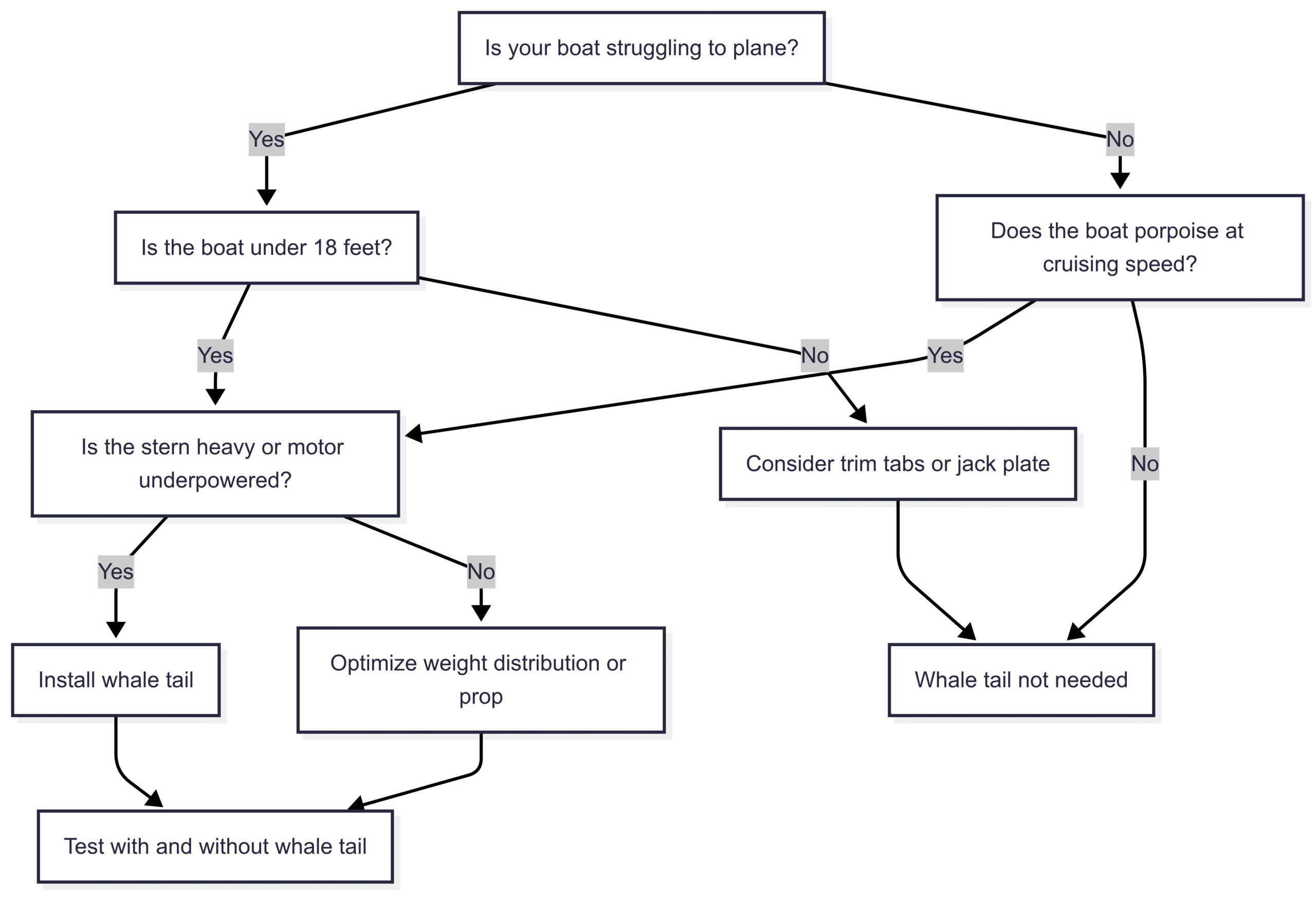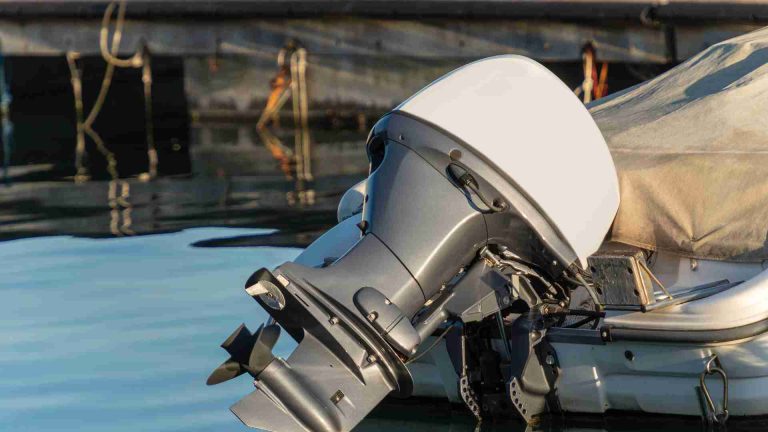When to use whale tail on outboard?
Discover when to use a whale tail on your outboard motor to boost performance, improve hole shot, and reduce porpoising effectively.
A whale tail, also known as a hydrofoil stabilizer, is a fin-like device attached to the cavitation plate of an outboard motor. Its primary function is to harness the energy from the propeller wash to generate lift at the stern, facilitating a smoother transition from displacement to planing mode. This accessory has sparked considerable debate among boaters, with some praising its benefits for specific applications and others questioning its necessity. This article explores the scenarios where a whale tail is advantageous, its benefits and drawbacks, and practical considerations for its use, particularly for boats like a 14-foot V-hull runabout with a 90 HP 2-stroke Mercury outboard.
Understanding the Functionality of a Whale Tail
A whale tail operates by redirecting the water flow from the propeller, creating upward lift at the stern. This lift helps the boat achieve a planing position more quickly, reducing bow rise and stabilizing the vessel. The design mimics an airplane wing, where water flowing over the hydrofoil generates lift, counteracting the downward force of the boat’s weight. This mechanism is particularly effective for boats that struggle to get on plane or experience instability at higher speeds.
Key Benefits of Using a Whale Tail
- Improved Hole Shot: The hole shot refers to the boat’s ability to transition from a standstill to planing speed. Whale tails excel in reducing the time and distance required for this transition, especially for boats with heavy sterns or underpowered engines. For example, a 16-foot aluminum boat with a 90 HP motor can plane in a boat length instead of requiring a 200-foot run-up, as noted by a boater on a forum.
- Reduced Porpoising: Porpoising, the up-and-down rocking motion at higher speeds, can be mitigated by a whale tail. The lift generated helps keep the boat level, improving ride comfort and safety. This is particularly beneficial for smaller planing-hull boats prone to this issue.
- Enhanced Stability: Whale tails improve handling, especially during turns. The additional lift stabilizes the boat, reducing the tendency to lean excessively or “dogleg” in crosswinds, as one user reported with a 16-foot Starcraft.
- Reduced Cavitation: Cavitation occurs when air bubbles form around the propeller, reducing thrust. A whale tail can minimize this by stabilizing water flow, ensuring consistent propeller performance.
- Potential Fuel Efficiency: By enabling faster planing and reducing drag at cruising speeds, whale tails may improve fuel efficiency. However, this benefit varies depending on boat configuration and operating conditions.
- Increased Trim Control: Whale tails provide additional control over the boat’s trim, allowing boaters to adjust the angle for optimal performance. This is particularly useful for maintaining a level ride in varying conditions.
Potential Drawbacks of Whale Tails
- Reduced Top Speed: A common criticism is the potential for decreased top speed due to added drag. Users report losses of 1-3 MPH, with one boater noting a drop from 37 MPH to 25 MPH on a 16-foot boat. However, this depends on engine height and trim settings.
- Limited Effectiveness on Larger Boats: Whale tails are less effective on heavier or larger boats, particularly those with trim tabs or well-balanced weight distribution. For instance, a 20-foot, 2400-pound center console may see minimal benefits compared to a 14-foot aluminum boat.
- Risk of Damage: The hydrofoil can be damaged if it strikes the bottom or obstacles, especially in shallow waters. This risk is higher for boats with low clearance.
- Not a Universal Solution: Whale tails are not a cure-all. Issues like poor weight distribution or an incorrect propeller pitch may require alternative solutions, such as adjusting load or changing props.
When Should You Use a Whale Tail?
The decision to use a whale tail depends on your boat’s characteristics, motor setup, and intended use. Below are scenarios where a whale tail is most beneficial:
1. Small, Lightweight Boats
Whale tails are most effective on smaller boats, typically under 18 feet, with planing hulls. These boats often struggle to get on plane, especially if equipped with smaller or underpowered engines. A 14-foot V-hull with a 90 HP motor, like the one described, is a prime candidate for a whale tail, as the oversized motor may cause stern-heavy issues that the hydrofoil can address.
2. Stern-Heavy Boats
Boats with heavy sterns, either due to large motors or uneven weight distribution, benefit significantly from whale tails. The lift provided helps counteract the stern’s downward pull, enabling faster planing and better handling.
3. Underpowered Boats
For boats with engines below the maximum recommended horsepower, a whale tail can compensate by improving hole shot and planing efficiency. For example, a 16-foot boat with a 9.9 HP motor may see a “night and day” difference with a hydrofoil.
4. Boats Experiencing Porpoising
If your boat porpoises at cruising speeds, a whale tail can stabilize the ride by keeping the stern lifted. This is particularly useful for boats without trim tabs.
5. Applications Requiring Quick Planing
Boats used for watersports, such as skiing or wakeboarding, benefit from faster hole shots. A whale tail can reduce the time to plane, making it easier to pull skiers or boarders.
When to Avoid a Whale Tail
- Well-Equipped Boats: Boats with trim tabs or jack plates may not need a whale tail, as these devices offer superior control over trim and planing.
- High-Speed Performance Boats: If top speed is a priority, the drag from a whale tail may outweigh its benefits. For such boats, optimizing propeller pitch or engine height is more effective.
- Larger, Heavier Boats: Boats over 20 feet or weighing more than 2400 pounds, like a 2004 Palm Beach 205, may see negligible benefits due to their size and weight.
- Properly Configured Boats: If your boat planes well and has no porpoising issues, a whale tail may be unnecessary. As one boater advised, “If your boat planes out good, don’t put a whale tail on it.”
Practical Considerations for Installation and Use
Installation Process
Installing a whale tail is straightforward, typically requiring only a few bolts to attach it to the cavitation plate. A YouTube video by Dustan Balkcom demonstrates the process, emphasizing proper alignment to avoid steering issues. Ensure the hydrofoil is compatible with your motor’s horsepower, as some models are designed for specific ranges (e.g., 40-300 HP).
Engine Height and Trim
Proper engine height is critical when using a whale tail. If the motor is mounted too low, the hydrofoil may remain submerged at cruising speed, increasing drag and reducing top speed. Boaters on forums recommend raising the motor one or two holes if the cavitation plate is below the waterline when trimmed properly. For example, a boater with a 20-foot Palm Beach 205 found the motor too low, causing drag and limiting RPMs to 5200-5600 instead of the desired 6000.
Propeller Selection
The propeller’s pitch and blade configuration significantly affect performance with a whale tail. A lower pitch (e.g., 14×16 instead of 14×18) can improve hole shot and RPMs, especially for underpowered boats. A 4-blade prop may also enhance planing over a 3-blade prop, as suggested by a forum user.
Weight Distribution
Before installing a whale tail, optimize weight distribution. Moving gear forward or redistributing passengers can reduce stern heaviness, potentially eliminating the need for a hydrofoil. For a 14-foot V-hull with a 90 HP motor, the boater noted gear offset the stern-heavy motor, which may reduce the whale tail’s necessity.
Testing Performance
To determine if a whale tail is beneficial, test the boat with and without the hydrofoil. Measure hole shot time, top speed, and RPMs at various trim settings. For instance, a boater with a 16-foot aluminum boat reported a significant improvement in planing distance with a whale tail, but a slight top speed reduction.
Specifications and Pricing
Whale tails vary in design, material, and compatibility. Below is a table summarizing popular models and their specifications:
| Brand/Model | Horsepower Range | Material | Price (USD) | Features |
|---|---|---|---|---|
| SE Sport 300 | 40-350 HP | Plastic | $40-$60 | Easy installation, universal fit |
| StingRay XRIII | 40-300 HP | Composite | $100-$150 | Anti-slip design, improves hole shot |
| Permatrim Hydrofoil | 50-300 HP | Aluminum | $150-$200 | Durable, suitable for larger motors |
| Davis Doel-Fin | 5-50 HP | Plastic | $30-$50 | Budget-friendly, ideal for small boats |
Prices are approximate and based on online retailers like Amazon and West Marine.
Chart: Decision Tree for Whale Tail Use
Below is a decision tree to help determine if a whale tail is appropriate for your boat:

Real-World Experiences and Insights
Boaters on forums like Reddit and The Hull Truth provide valuable insights into whale tail performance. A user with a 16-foot Starcraft and a 90 HP motor reported a dramatic improvement in planing, stating, “It makes the boat go from standing up on its ass to jumping straight up level on plane.” However, another user with a 2006 Moomba Outback V noted that benefits are often overstated, suggesting alternatives like jack plates or different props for better results.
For a 14-foot V-hull with a 90 HP Mercury, the oversized motor may cause stern heaviness, making a whale tail a viable option. However, the boater’s concern about a tight motor cover suggests removal might be necessary for practical reasons. Testing without the whale tail, as the user planned, is a prudent approach to assess its impact.
Alternatives to Whale Tails
- Trim Tabs: More effective for larger boats or those requiring precise control, trim tabs adjust the boat’s attitude dynamically. They are more expensive ($500-$1000) but offer greater versatility.
- Jack Plates: These allow adjustable motor height, improving performance by reducing drag. They cost $300-$1000 but are ideal for optimizing top speed.
- Propeller Adjustments: Switching to a lower-pitch or 4-blade propeller can enhance hole shot and planing without the drag of a whale tail. Props range from $100-$500.
- Weight Redistribution: Moving gear or passengers forward can address stern heaviness, often at no cost.
Conclusion
A whale tail is a cost-effective accessory for small, stern-heavy, or underpowered boats struggling with hole shot or porpoising. It offers significant benefits in planing speed, stability, and trim control, particularly for boats like a 14-foot V-hull with a 90 HP Mercury. However, it’s not a universal solution, and drawbacks like reduced top speed or limited effectiveness on larger boats must be considered. Before installing a whale tail, optimize weight distribution, propeller selection, and engine height. Testing with and without the hydrofoil is crucial to determine its value for your specific setup. For boaters seeking improved performance on a budget, a whale tail can be a game-changer, but alternatives like trim tabs or jack plates may offer superior results for more demanding applications.
Happy Boating!
Share When to use whale tail on outboard? with your friends and leave a comment below with your thoughts.
Read Image of the Mayflower Ship 4K HD Wallpaper until we meet in the next article.






